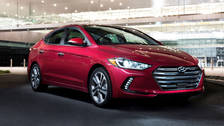Sixth-gen sedan ups the ante on inexpensive transportation
Let me put on my old man hat for a minute:
Back in my day (which was the early ’90s), the crapboxes were crapboxes and the nice cars were … still pretty bad. The kids today, though, have it so much easier with their Ford Focuses and their Mazda 3s and their Hyundai Elantras, all of which offer heated seats, sunroofs and music player hookups. We had to carry around a 15-pound book that we stored compact discs in. Discs, I say! The new Elantra is closer to a Rolls-Royce than to my 1987 Ford Escort.
So this Elantra’s new — all-new according to Hyundai. The sixth-generation compact sedan takes a step forward in just about every category including quietness, stiffness, economy and fun. It won’t beat a Focus ST around a track and it’s not going to drop jaws like the Alfa 4C, but it will make you say, “Damn, this thing is nice,” with a surprised tone … and you shouldn’t be surprised, because Hyundai’s been making damn nice cars for nearly a decade.
Overall, this car is sharp. The new snub-nose front end gets Hyundai’s hexagonal grille and vertically stacked LED fog lights. In back, the taillights were massaged a bit and the edge of the trunk now forms into a faux spoiler. I’m not in love with the profile, though: Like EVERYTHING, the Elantra was designed to cheat the wind. Hyundai succeeded with a coefficient of drag at 0.27, just one-hundredth higher than the BMW i8. But if you put this next to the new Cruze, the new Focus and the Dodge Dart, they’re all the exact same shape.
The cabin is quiet and understated, and the doors have a decent heft and a nice thud when they close. The seats in this Limited model that we tested are leather, but they’re not super soft. That might be because Hyundai uses SoyFoam for padding. On the bright side, in a pinch you can eat it. Just kidding (but we’ll check).
The Elantra’s not trying to be fancy. There are only a few colors and a few different surface textures and everything is laid out logically. The hard plastic on the doors feels a little cheap but the wheel and gear shifter are nice to touch.
Apple CarPlay and Android Auto are part of the $ 2,500 Technology package, which also adds a premium audio system, HomeLink, a screen in the gauges and a few other bits. It makes working with an iPhone, especially if you listen to podcasts, much easier — that can become a pain with some systems.
Our tester came with the Ultimate package, which gets all the autonomous safety features such as lane keeping, backup camera and forward collision warning. As much as I sometimes complain about these, they will give you an early warning when the car in front of you stops for no reason, and just generally remind you to pay attention. It also gets heated back seats, which is a nice touch for the second and third passenger.
The Elantra gets two new powertrains for 2017. The first, which is installed on the base SE and Limited trims, is the 2.0-liter Atkinson cycle four that produces 147 hp and 132 lb-ft of torque. A six-speed automatic sends power forward, resulting in combined rating of 33 mpg. It feels a little sluggish in the normal driving mode, and more so in eco, but in sport it really livens up. Upshifts come late in the rev range and downshifts come early. Steering tightens up as well, which makes for an entertaining drive to work. There’s not a lot of “feel,” but the ratio is quick.
The other engine, which will be offered exclusively in the Elantra Eco, is a 1.4-liter four making 128 hp and 156 lb-ft. That’ll be mated to a seven-speed dual-clutch trans, good for 35 mpg combined.
This new Elantra is lighter than the outgoing model and stiffer with more high-strength steel. The rear torsion bar suspension has been redesigned and got bigger rear bushings. A coil-spring, MacPherson setup does a good job in front. Most bumps are absorbed, but bigger ones will wiggle their way into the cabin. Again, it’s very quiet on the road. There’s some body roll when pushing it into corners, but no more than any other car in this non-enthusiast class.

The Limited trim comes in at $ 23K or so, which seems like a reasonable deal, considering the competition. Our loaded tester with the Tech and Unlimited packages goes up to almost $ 28,000, which is rounded up to $ 30,000 in most people’s eyes. That’s hefty for a car that straddles the line between compact and midsize. You could ditch the safety features and the premium audio/Apple CarPlay stuff and still have a USB input and get back down to around $ 23,000 again (which we suspect rounds to $ 20K in most buyers’ minds). In that sense, it seems like a good deal. I think Hyundai outstyled its main competitors and it still has that 100,000-mile powertrain warranty.
If the Elantra isn’t on your list of test drives, you should put it there.
Options: Technology package including navigation system AVN 4.0 with 8-inch touchscreen, Android Auto and Apple CarPlay, premium audio with eight speakers, including a center channel and subwoofer, 4.2-inch TFT color instrument cluster display, power sunroof, heated front and rear seats and auto-dimming rearview mirror with HomeLink and compass ($ 2,500); Ultimate package including HID headlights with dynamic bending light, automatic emergency braking with pedestrian detection, smart cruise control, lane keep assist system, integrated memory system for driver’s seat and outside mirrors ($ 1,900); carpeted floor mats ($ 125)



























